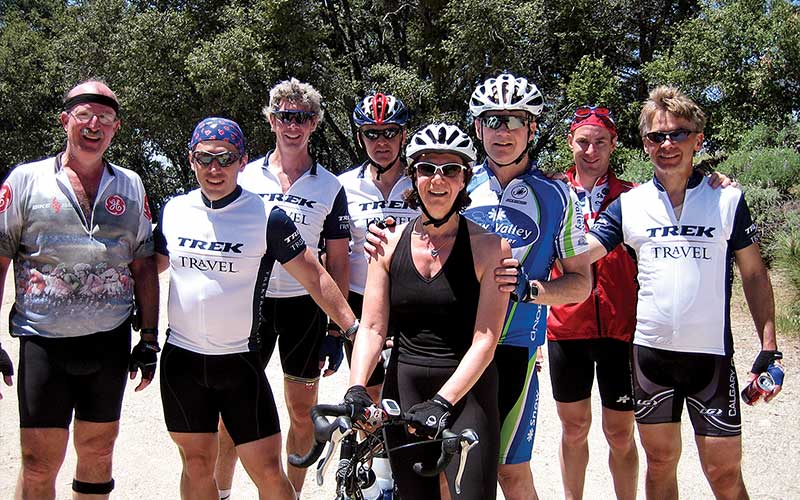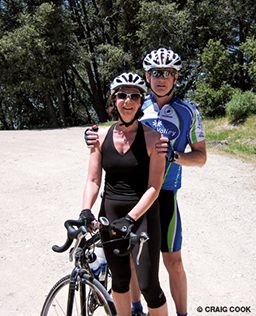The day started out beautifully in Solvang, Calif., a funky little town known as “Little Denmark” for its Danish architecture. My husband, Craig, and I were on a five-day road-bike training clinic offered by performance-bike travel specialists, with an emphasis on climbing and descending skills. Having a former professional cyclist to coach us was an added bonus, as I was training for an early-season triathlon with lots of hills on the bike segment. We were on our first day of serious climbing and looking forward to a 10-mile ascent up Mount Figueroa. I was excited and inspired; it had been rumored that the esteemed U.S. Postal cycling team had done some of their training on this mountain, famous for its steep inclines and beautiful scenery.
We started out as a group of about 16 in the early-morning fog. By the time we hit the first rest stop at the bottom of the mountain, the fog had burned off, and it was a glorious spring day. I started off from the rest stop on my own because I knew most of the guys would climb faster than me, and this would help to keep the group together by the time we hit the summit.

Only two miles up the mountain, a group of my fellow travel companions blew past me. I knew I had to keep a steady pace and ride at my own rhythm if I was going to get this job done. Craig caught up with me about a mile further up the mountain and stayed with me, taking pictures along the way. There was a short, steep (the grade was at least 18 percent), rutted descent, and then continuous climbing until we hit the summit. Leaving the overlook, we started down with Craig in the front. There was a sheer drop off to my right, but we were going pretty slowly as we maneuvered around the holes in the road. Soon, though, I began to pick up speed, and I realized I had no brakes.
Before I could really react, I was going full out, passing Craig and trying to keep the bike on the road. I continued to pick up speed. The road started to ascend again, and gravity slowed the bike naturally. I continued to climb knowing there were no more descents before the summit.

enjoying a wonderfully active holiday during an arduous 10-mile ascent
along California’s Mount Figueroa.
Nothing like this had ever happened to me before. I have cycled 3,600 miles across the northern tier of the United States as well as the entire East Coast, from Maine to Florida. But this was the first time I hadn’t brought my own bike on a cycling trip because the tour company provided a high-end Trek bicycle. Since I had been considering buying that particular bike, it seemed a good chance to try it out.
We reached the summit, and life was good. I gave my bike to the tour guide/mechanic for servicing and asked to go down the mountain in the van. My confidence in the bike was gone. The tour guide took the bike and adjusted it; he assured me the bike was functioning properly and the brakes were now fine. In retrospect, I should have stuck with the van plan; it would have changed my day and my life.
After the last cyclists had a chance to cool down and eat some food, it was time to get back on the road. We started off at a very slow speed, once again picking our way around potholes and debris. The brakes were holding. So far so good. It really was a perfect day; the road became better paved, and our speed picked up.
While descending, I routinely worked my brakes because the road was winding and did not allow for much speed. Although we were speeding up, I still worked the brakes. So when the brakes failed a second time, I knew immediately there was a problem. I screamed for help, “I have no brakes!” Our guide yelled at me to give the brakes all I had. I incredulously thought, “What do you think I’m doing?“
My concentration was entirely focused on keeping the bike under control, my weight balanced and trying those brakes with everything I had. The S-curves were coming faster and faster, and there was no way I was going to make it through the fourth one. My inner voice told me that I had to get myself out of this; it was up to me to save myself. At the terminal velocity for keeping the bike under control, I had a stone wall on one side, a field on the other. I decided to take the bike off the road into the field. The choice was easy, dealing with the consequences less so.
I realized immediately I was stuck in some sort of tree. When Craig was beside me, I told him I wanted out. He instructed me to stay put, but that was not an option for me. I attempted to take off my helmet, but for some reason my right hand wouldn’t work. So I tried with my left hand and removed it. Finally, Craig and Kevin Livingston, former teammate of Lance Armstrong, helped to extricate me from the tree and walked me to the side of the road. We sat by the edge of that mountainside road when I noticed it was quiet. Too quiet. Why wasn’t anyone talking? What was the problem? I knew I couldn’t bike out, but really, what was going on? Then I saw my reflection in Craig’s sunglasses. My face was a bloody, mangled, mess. I finally realized the situation was serious.
A car finally came by, and Kevin asked the driver to notify the ambulance we’d passed at a movie shoot up the mountain. The first responder was quick to the scene, and air rescue was called. The helicopter was there within 15 minutes, and I was evacuated to Santa Maria and the nearest medical center, Marian Medical Center. I wished I could see the scenery on that spectacular mountain range, but all of the adrenalin that had kicked in was gone, and I didn’t have the strength to lift my head.

I ended up with nine broken bones in my face, two broken hands and several broken ribs. My medical care in California was extraordinary, but no surgery was done until we got back home to Maryland. I am so thankful for my DAN membership, which covered all of my airlift expenses since I was more than 50 miles from home. Although we had primary medical insurance, it covered only the first $1,000 of the total $17,700 cost of the emergency evacuation. My DAN TravelAssist® benefit covered the remaining cost. Craig and I are very active divers, but this accident had nothing to do with that part of our life. Still, I was seriously hurt and needed evacuation. It was such a sincere relief to know we wouldn’t have financial concerns from the accident, for I had much more serious issues to contend with, like regaining my health!
The accident review determined that the brake tension was set incorrectly, and the bike mechanic actually loosened the tension after my complaint at the mountain summit and made the situation worse. Where I had braking capability at slow speeds, there was a tipping point where the brakes would no longer function with the momentum of a steep incline. The brake pads were also not functioning at a top-performance level because they were pitted and had embedded metal fragments.
After six surgeries, including a six-hour facial reconstruction, I am back on the bike and doing long distance, multiday rides again. I continue to race with my local team and am so grateful to be alive and healthy enough to ride. However, I will never forget the day my life changed and that DAN was there for me when I needed help.

Medic’s Perspective
It’s a common misperception that DAN is there for its members only when a member is hurt while diving. The truth is that DAN is here for you regardless of how you come to need assistance.
As a DAN Member, you are automatically enrolled in Travel Assist®, the membership benefit that provides you up to $100,000 in medical evacuation coverage. Travel Assist is not part of any dive accident insurance plan; it is a benefit of your individual ($35) or family ($55) membership and, therefore, applicable both to diving and nondiving accidents, provided you are more than 50 miles from home.
If ever you need it, you can access Travel Assist by calling the DAN Emergency Hotline (+1-919-684-9111). We’re here 24 hours a day, 365 days a year to assist you in your time of need.
If you have questions about your TravelAssist benefit, call the DAN Membership Team at +1-800-446-2671 or read all about it at www.DAN.org.
— Nicholas Bird, DAN CEO and chief medical officer
© Alert Diver — Q1 Winter 2011